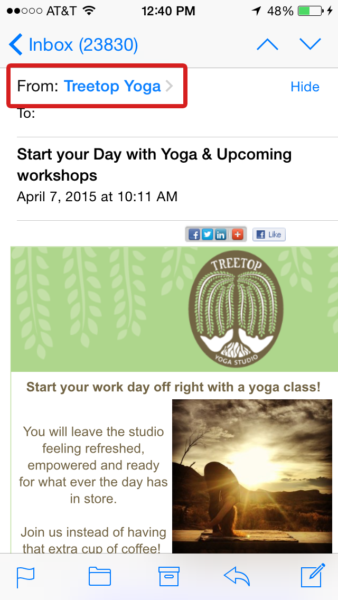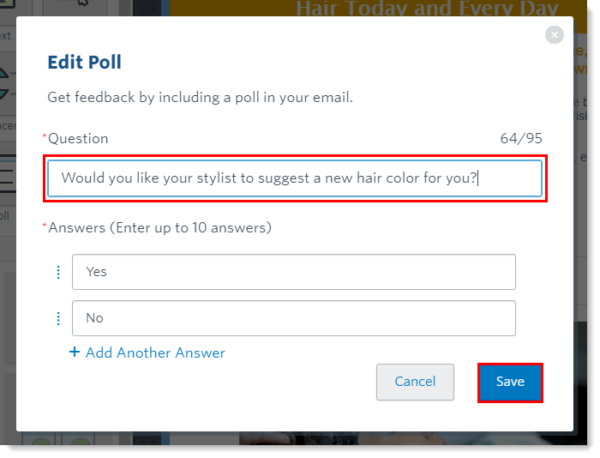
Want to know how to get customers to open your emails? It’s actually easier than you might think.
Email marketing works because it allows you to reach customers (and potential customers) in the place they go every day — the inbox. But once you get to the inbox, how do you make sure your emails actually get opened?
Luckily, improving your email opens doesn’t require a lot of heavy lifting.
With a few simple tweaks, you could be on your way to increased email open rates and more opportunities for your business.
In this article, we’ll fill you in on the latest developments in email open rates and give you five simple strategies you can use to get more people to open your emails.
- A quick note on increasing email open rates
- 8 ways to increase email opens from your customers
- 1. Invest in your subject line
- 2. Fix your “from name” and “from email address”
- 3. Find the best time to send (and be consistent)
- 4. Get to know your audience
- 5. Revisit your sign-up process
- 6. Segment your email list
- 7. Make your readers feel personally invested
- 8. Keep your contact list clean and up-to-date
- What’s one thing you could improve in your next email campaign?
A quick note on increasing email open rates
Email open rate (the percentage of people who open your emails) has long been a favored metric of email marketers, but things are changing. In September of 2021, Apple’s Mail Privacy Protection feature started to make it more difficult to measure the number of people who open your emails.
Previously, increasing email open rates was something many people set as a key goal in their email marketing. Now that open rates have become unreliable, there are other email marketing metrics you should focus on — ones that map more directly to your business goals.
That said, even though your ultimate goal isn’t simply getting more customers to open your emails, it’s still important that they open your emails. After all, how will they take a valuable action — like making a purchase — if they haven’t even seen your email? The only difference now is that rather than thinking about how to increase your email open rate, you’ll want to simply focus on how to make your email look interesting, valuable, and trustworthy enough to get more people to open it.
That’s what we’ll focus on in this article. So without further ado, here are five simple ways that you can get more customers to open your emails.
8 ways to increase email opens from your customers
While there are a ton of factors that determine how likely your email is to arrive in your customers’ inbox and motivate them to open, we’ll just focus on the five easiest and most important ones here. Make sure you’re thinking about all five things below with every email you send to maximize the number of customers that open your emails.
1. Invest in your subject line
Your email subject line is one of the most important lines of your entire email. Similar to an article headline or the tagline of an ad, your subject line is meant to draw people in and get them interested in what you have to offer.
Generic subject lines like “April Newsletter” or “News from [Your Business]” probably aren’t going to cut it.
Invest some extra time in your subject line before hitting send. Here are 5 ideas to help you get started:
- The question: Using a question in your subject line is a great way to make a more personal connection with the people viewing your emails.
- The command: Sometimes it pays off to be more direct with your audience as a way to get them to take action.
- The teaser: Believe it or not, people love cliffhangers. And if crafted correctly, the teaser tactic will pique interest and entice subscribers to read on.
- The list: Lists make it easier for people to consume the information you’re sending out. They also give you the chance to demonstrate your points in a more compelling way.
- The announcement: Subject lines don’t have to be complicated, especially if the goal of your email is to announce something new. Be straightforward about what your email is about.
Brand your subject lines when appropriate
While you may not always have room to inject your brand name into your subject line (the most effective subject lines are between five to seven words or 30 characters or less), it might be worth trying if you think people are having trouble recognizing your emails.
Here are a few simple ways to do it:
- [Patty’s Bakery] Pumpkin Muffins are Back!
- Pumpkin Muffins are Back at Patty’s Bakery!
- Patty’s Pumpkin Muffins are Back at the Bakery!
2. Fix your “from name” and “from email address”
Do you know what you used as the “from name” in your last email campaign? What about the “from email address”?
The from fields let readers know who an email is coming from. If you’re not thinking carefully about the information you put into these fields, you could be making it difficult for people to recognize your email when it lands in their inbox.
People are skeptical of emails when they don’t know the sender; they could be less likely to open and more likely mark your email as spam.

Use a familiar from name and from email address that represents your business. If possible use an email address with your business’s name in it, rather than a personal email.
Tip: Here’s how to customize your email header and footer within your Constant Contact account.
Choosing the right “From Name”
The easiest way to decide what your “From Name” should be is to answer the following question: “How will people quickly and easily recognize my business or organization?”
For some, it will be the name of your brand. For example, if Patty Smith owns a bakery with a strong local following, she should opt for Patty’s Bakery.
But if Patty is better known by her clients for her individual specialty cake services, she may want to use Patty Smith so that her clients will know it’s coming from her.
Choosing the right “From Email Address”
The email address you decided to use when you first set up your email marketing account may not be the same email address that you want to use today.
While it may seem like a small detail, for 68 percent of consumers, familiarity with the person sending the email is the top reason why they decide to open.
If you’re still using a personal email address (patty@yahoo.com) instead of your branded business email (pattysmith@pattysbakery.com), you could be missing out on another way to make your emails instantly recognizable.
3. Find the best time to send (and be consistent)
There are certain times of days when your readers are more likely to open and read your emails.
One of the easiest ways to find the best time to send is to segment your list into 2-3 equally sized groups and send the same copy of your email during different times of the day (morning, afternoon, and evening). Try this test for a few different mailings and keep track of which version gets the most engagement.
This will take a little extra time, but over the course of a few weeks, you should have a strong indication of when your readers are most likely to open.
To help you determine the best day/time to send, we analyzed a collection of Constant Contact customer mailings. You can use this chart to identify a good time to send, based on the results of others in your industry.
Not sure how to measure your email’s engagement? Check out our article on email marketing metrics that go beyond just opens and clicks.
4. Get to know your audience
You may know and understand the needs of your customers, but how much do you really know about the people on your email list?
Do you know what topics they’re interested in? Do you understand why they joined your email list? Do you have a good understanding of what questions they’re asking and how you can help address them?
Understanding your email audience is critical to getting the results you want from your email campaigns. When you learn more about your list, you can start to target your contacts with more relevant information.
Here are three ideas to help you do it:
- Survey: Send a short 1-3 question online survey to find out what topics your readers are interested in learning more about.
- Poll: Ask readers to take a quick, one question poll. You can add a poll right within your Constant Contact account.
- Reports: Use your click reports to see which links are getting the most clicks.
- In-person: You’re interacting with customers every day. Get in the habit of writing down customer questions/feedback so that you can refer back to it when you’re stuck for email ideas.
5. Revisit your sign-up process
Successful open rates start the moment someone joins your email list. It’s your responsibility to make sure they understand what they’re signing up for, and then follow through with the expectations you have set.
Take a look at your email list sign-up form. Make sure you’re answering the following questions:
- What is the value of signing up?
- What can they expect to receive?
- How often will they hear from you?
In addition to your sign-up form, take a look at all of the ways you’re adding people to your email list.
Are you getting permission before adding new contacts to your list? You’ll get a much better response rate when people opt-in to join your list. You’ll also avoid possible spam complaints that could keep you from reaching the people on your list.
6. Segment your email list
Segmenting your email list based on audience interest and behavior is one of the most effective ways to increase your opens.
A Constant Contact study found that campaigns sent to 35 subscribers or less, suggesting more personalized content, saw incredible open rates at an average of 55 percent.
Meanwhile, campaigns sent to more than 7,500 subscribers, suggesting low personalization, averaged about a 14 percent open rate.
If you’re still working with one large email list, think about the ways you can reach out to smaller more targeted groups. Are there ways you can organize your contacts based on their location, interest, or purchasing behavior?
7. Make your readers feel personally invested
Good news for nonprofits! Our email data shows that nonprofits generally enjoy higher open rates than their business-to-consumer (B2C) and business-to-business (B2B) counterparts.
Taking a closer look at specific industries, religious organizations and medical services receive over a 30 percent open rate, while product and service businesses, as well as consultancies, see lower results on average.
This speaks to the level of investment email subscribers feel with associations they are passionate about, and offers valuable opportunities for other industries to think about how they can further their connection with subscribers.
Think about how you can make your subscribers feel invested in your business by offering something of value. We recommend using an 80/20 rule, where 80 percent of your content offers value to your subscribers and 20 percent is promotional content. If you’re unsure what your specific audience will find useful, send out an online survey to get their input.
8. Keep your contact list clean and up-to-date
How often are you sorting through your contacts to check for addresses with ongoing issues? Have you ever sent out an “update profile form” to ensure you’re reaching subscribers at their most up-to-date address?
Spend some time cleaning your email list and look for opportunities to resolve any issues with addresses that may be out of date.
What’s one thing you could improve in your next email campaign?
When it comes to email open rates, small improvements can make a big difference.
This is especially important as more email clients include tabs that file your emails as “promotions” alongside other companies your subscriber has signed up to hear from. Your emails will be competing directly with other brand updates and promotions, so it’s crucial that you’re making your emails recognizable and communicating why people should open them..
The best way to stand out is to make sure the people who already know, like, and trust your business can recognize you right away!





